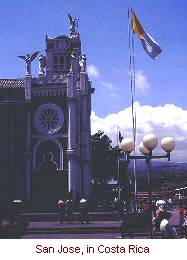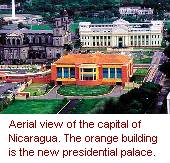|
|
|
|

|
Nicaragua
|
 The U.S.-backed Nicaraguan Somoza government allows Cuban exiles to use Nicaragua as a launching pad for the Bay of Pigs invasion. This creates animosity between Fidel Castro and the Somoza government.
The U.S.-backed Nicaraguan Somoza government allows Cuban exiles to use Nicaragua as a launching pad for the Bay of Pigs invasion. This creates animosity between Fidel Castro and the Somoza government.
A
brief history
of Nicaragua in the 20th century.
A group of armed guerillas known as the Sandinist National Liberation Front (FSLN) or Sandinista, organise themselves to overthrow the corrupt Somoza government. The founders are Marxists and are supported by Fidel Castro.
Read more on the
FSLN
Anastasio Somoza becomes president. His rule is so corrupt that many young Nicaraguans in the poorer classes of society turn to join the rebel Sandinistas.
Find out more about the
Samoza dynasty.
An earthquake devastates Nicaragua. Instead of using the international aid that pours in for the people, the Somozas pocket the money. This intensifies the widespread dissatisfaction of the Nicaraguan people with the Somoza government.
Chamorro, the leader of an opposition group in Nicaragua, is assassinated. His death sparks off public violence and a general strike. The revolt spreads and former moderates join with the FSLN to overthrow the Somoza regime.
In Nicaragua, the Sandinistas launch an all-out offensive to force the Somozas to resign. The Organization of American States places pressure on Somoza to resign, and turns over power to a Council of National Reconstruction, selected by the Sandinistas.
The Sandinistas take power in Nicaragua.
 The Sandinista government establishes close relations with Cuba and the Soviet Union. The United States, afraid that this move would expand communism in Central America, suspends economic aid to Nicaragua. President Reagan decides to support Nicaraguan counterrevolutionary guerillas known as Contras. These insurgents establish their bases in Honduras and Costa Rica.
The Sandinista government establishes close relations with Cuba and the Soviet Union. The United States, afraid that this move would expand communism in Central America, suspends economic aid to Nicaragua. President Reagan decides to support Nicaraguan counterrevolutionary guerillas known as Contras. These insurgents establish their bases in Honduras and Costa Rica.
The Contras, Cocaine and Covert Operations.
What
really took place?
The U.S. Congress prohibits the Defense Department from providing military aid to the contras. The Reagan administration circumvents these limitations and supervises covert military aid to the Contras. The United States and the contras resort to armed forces to topple the Sandinista government. The Honduran government allows the contras to attack Nicaragua from their country. This brings the two countries to the brink of war.
A picture of
President Reagan
meeting with Contra leaders.
The United States imposes a trade embargo on Nicaragua that lasts five years. This strangles Nicaragua's economy.
United States support for the Contras is discovered. It is revealed that the CIA had illegally sold weapons to Iran at inflated prices, and used the profits to fund the Contras. The Reagan administration is forced to disclose the arms deals.
The
Iran-Contra Affair
in perspective.
Watch the CNN video on
the hearing.
The U.S. Congress vote against supplying further military aid to the Nicaraguan Contras.
 Responding to pressure from Central America's presidents, Nicaragua holds internationally-monitored elections. Opposition parties form the U.S.-endorsed and U.S.-financed National Opposition Union (UNO), with Chamorro running for the office of president. The UNO win the elections. Shortly after this, the United States lifts its trade embargo. The Contras cease fighting.
Responding to pressure from Central America's presidents, Nicaragua holds internationally-monitored elections. Opposition parties form the U.S.-endorsed and U.S.-financed National Opposition Union (UNO), with Chamorro running for the office of president. The UNO win the elections. Shortly after this, the United States lifts its trade embargo. The Contras cease fighting.
Read more about
Nicaragua.
|




 The U.S.-backed Nicaraguan Somoza government allows Cuban exiles to use Nicaragua as a launching pad for the Bay of Pigs invasion. This creates animosity between Fidel Castro and the Somoza government.
The U.S.-backed Nicaraguan Somoza government allows Cuban exiles to use Nicaragua as a launching pad for the Bay of Pigs invasion. This creates animosity between Fidel Castro and the Somoza government.
 The Sandinista government establishes close relations with Cuba and the Soviet Union. The United States, afraid that this move would expand communism in Central America, suspends economic aid to Nicaragua. President Reagan decides to support Nicaraguan counterrevolutionary guerillas known as Contras. These insurgents establish their bases in Honduras and Costa Rica.
The Sandinista government establishes close relations with Cuba and the Soviet Union. The United States, afraid that this move would expand communism in Central America, suspends economic aid to Nicaragua. President Reagan decides to support Nicaraguan counterrevolutionary guerillas known as Contras. These insurgents establish their bases in Honduras and Costa Rica.
 Responding to pressure from Central America's presidents, Nicaragua holds internationally-monitored elections. Opposition parties form the U.S.-endorsed and U.S.-financed National Opposition Union (UNO), with Chamorro running for the office of president. The UNO win the elections. Shortly after this, the United States lifts its trade embargo. The Contras cease fighting.
Responding to pressure from Central America's presidents, Nicaragua holds internationally-monitored elections. Opposition parties form the U.S.-endorsed and U.S.-financed National Opposition Union (UNO), with Chamorro running for the office of president. The UNO win the elections. Shortly after this, the United States lifts its trade embargo. The Contras cease fighting.
